Top 10 Productivity Secrets by Ilona Mask
- Transfer

This summer I read Elon Musk's book Tesla, SpaceX, and the Quest for a Fantastic Future. Wonderful reading and detailed story about the ups and downs of one of the largest visionaries of our time. The book also made it possible to get acquainted with the working ethics of the Mask and the secrets of productivity that he uses to manage several companies.
Many will agree with the opinion that Elon Musk has an extraordinary mind, huge ambitions and energy. But I believe that we, mere mortals, may well use some of his secrets of productivity in our daily lives.
1. Start the day with mission critical work.
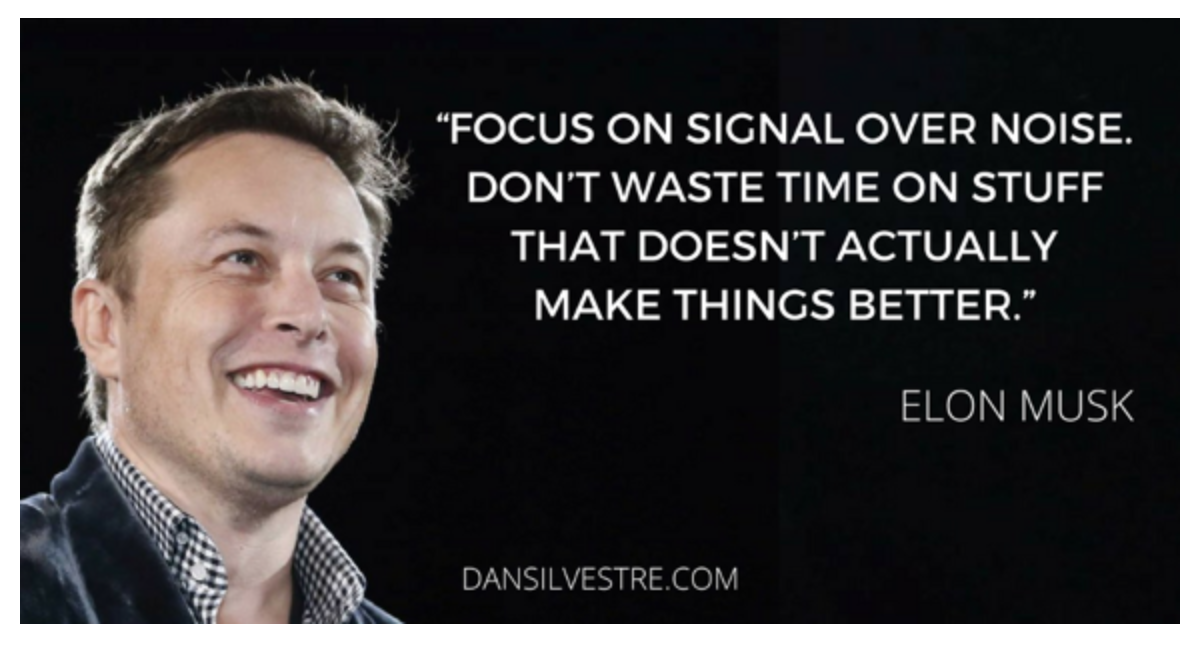
As the CEO of three companies - Tesla , SpaceX and Neuralink - the Mask has to do many things every day.
Therefore, he begins the day with the most important tasks. In his case, it is writing emails so that other people start / continue to work, so that things move. Usually his day starts at 7 in the morning, Musk answers letters at least half an hour. He meticulously eliminates what is not critical right now and focuses only on key topics.
As he said in a speech at USC Commencement:
“Focus on the signal, not the noise. Do not waste time on what is actually not good. ”
How to apply
Choose your most important task (SVZ) for this day and take it first. The SVZ should have the greatest impact on your work.
For example : my most important task is to write great text. Therefore, I always start my day by sitting down and writing. I will not proceed to the next task until I write at least 1000 words.
The Paretto rule (80/20) will help you choose the SVZ. Make it your habit to solve SVZ first before moving on to other tasks.
2. Use feedback loops

Mask has a very busy schedule, often he has to work in several places during the day. Therefore, he constantly tries to optimize his time costs.
Although Musk admits that he has not read any time management books, he shares some useful advice:
“I think it’s very important to have a feedback loop when you constantly think about what you’ve done and how you could do it better. So the best advice is to constantly think about how you could do something better. ”
Musk uses not only his own feedback, but also the opinion of other people: it encourages the search for desirable negative reviews. This can be frustrating at first, but usually negative feedback can be much more beneficial.
Musk is also looking for the best people in any field, providing constant and trustful feedback.
Reducing the feedback loop improves efficiency, speeds up implementation, and allows you to create better products.
How to apply
This approach works great both in professional activities and in ordinary life.
Gather your team and get feedback on a specific product, feature, management style, business process or anything else that you are currently trying to improve.
"Don't tell me what you like, tell me what you don't like."
You can do the same with your friends. And although negative reviews can be erroneous, you will know that friends are simply trying to help, and they have good intentions.
3. Reasoning from the root causes

The “ root cause ” is a basic assumption that cannot be deduced from any other. This is the only one undeniable in a difficult task.
Musk argues based on the root causes , and not by analogy (for example, with past experience). Thus, reasoning is built from scratch:
“You look at the basics, build reasoning on them, and then you see if your conclusion works. It may differ, or may coincide with what people have done before. But it’s more difficult to think this way. ”
Here's an example of how Musk argues based on the root cause :
"What is the rocket made of? From aerospace aluminum alloys, titanium, copper and carbon fiber. Then I asked, what is the cost of these materials in the product market? It turned out that the cost of materials is about 2% of the typical cost of a rocket. "
And instead of buying ready-made rockets for millions of dollars, Musk decided to purchase materials in order to build cheap rockets on his own. This is how SpaceX came about.
How to apply
Reasoning on the basis of root causes makes you think differently. The root cause is the ability to get to the root of the problem. It is necessary to break the task down into its constituent elements.
There are three main steps in applying such a thought framework:
1. Recognizing and defining current assumptions : When faced with a task, write down your current assumptions about it.
2. Highlight the root causes: Find the basic, basic truths or elements of a task. As Musk says: “Drop everything, leaving only fundamental truths, and say“ well, that which we are sure of is true ”... and proceed from this, build reasoning.”
3. Create new solutions : if in the previous two stages you decomposed the task into components, now you are ready to create new solutions from scratch.
If you want to learn more about the way of thinking Mask and reasoning based on the root causes, then read this wonderful article: The Cook and the Chef: Musk's Secret Sauce .
4. Use asynchronous communications
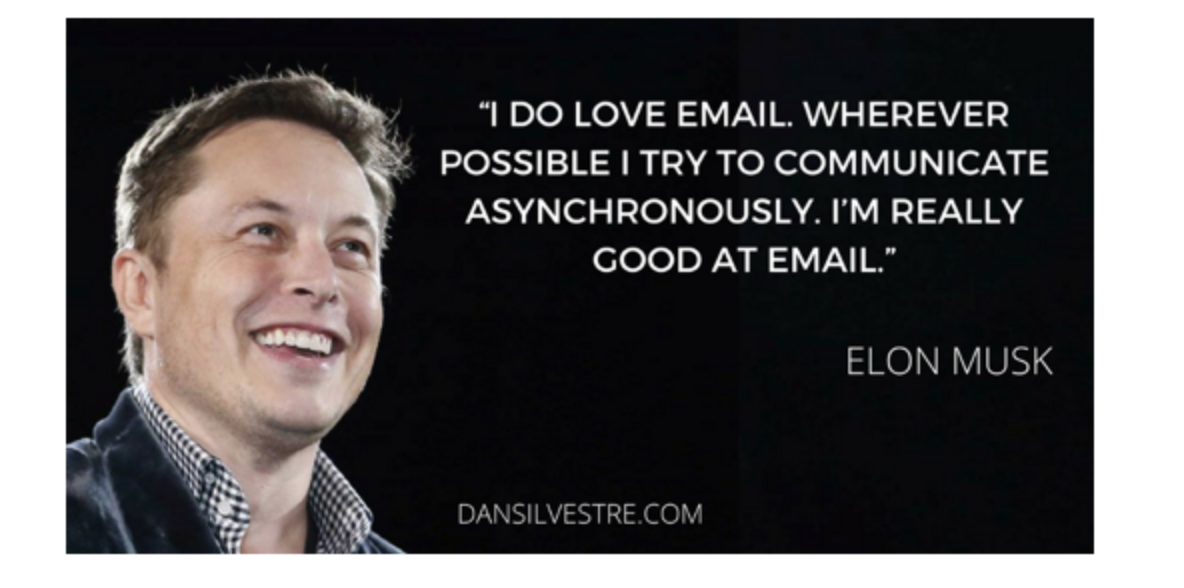
The first of these hacks gave you a little hint: Musk prefers to communicate on his own terms. That is, by default it uses email and text , asynchronous communication methods.
“I love email. I try to communicate asynchronously whenever possible. I am very good at mail. ”
And thanks to the use of a hidden address, it is difficult to contact those who do not work in his companies. This allows the Mask to focus on work tasks.
How to apply
Progress in business depends on the concentration and application of the principles of Deep Work . This means living as asynchronously and with minimal distraction from colleagues.
Three decisions on how you can start working on your own terms (in order of increasing difficulty):
1. Turn off notifications : close all notifications on your phone, computer and any other gadgets. If there is anything really important, they will call you.
2.Do not go to meetings: Do not agree to meet until there is a clear agenda and until you know what result you can expect. If possible, use email instead of appointments.
3. Work remotely : a noisy office is distracting, and you can work in silence at home <ha, the author has no small children - approx. transl.>. If this is not possible, try to knock yourself a separate room.
To achieve results in important work , try to be distracted as little as possible.
5. Manage communications
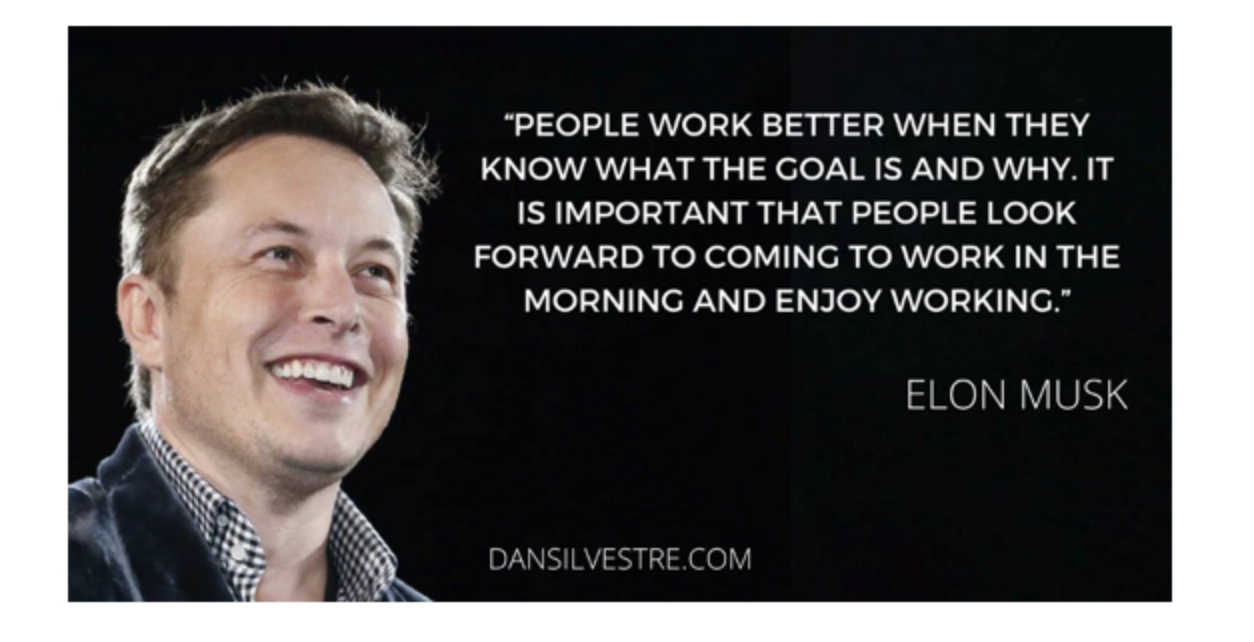
When Musk does not build rockets and does not revolutionize the automotive industry, he can be "reached" only by mail. He jokes at conferences: “I send a lot of letters - I mastered it perfectly. This is my main competency. ”
In his letters, Musk is expressed very clearly, briefly and directly. For example, read a letter sent to all staff about the use of abbreviations, aptly titled “ Acronyms Seriously Suck ”.
He often sends letters to entire companies with news, with instructions on communications , about the vision and mission of the company, about how to be more productive in work.
“People work better when they know the purpose and reason. It is important that people look to the future when they come to work in the morning and enjoy it. ”
He also expertly performs in public, sincerely talking about complex ideas in simple language. Musk often speaks in the present tense when it comes to visionary topics. This is a language trick that evokes a sense of the future for the audience.
How to apply
According to a study by Carleton University, a third of the work week of a “typical” mental worker is spent on correspondence. Therefore, communication by mail is akin to art.
You need to express yourself briefly, but at the same time convey your thoughts. Every word counts in the mail. Here are some suggestions:
Be brief : don't write ten expressions when two are enough. You can practice this way: take your letter, written in the usual manner, and halve the number of words.
Avoid Soft Words: do not write “I feel”, “I am not sure”, “maybe”, avoid the passive form and any germs. All this is wasting your time and your recipients, leading to confusion and misunderstanding.
Know what you want : think about what you want to achieve with your letter, and first of all, state it in plain language. After some practice, this statement will be a letter.
Highlight the important in bold : if in correspondence with several recipients you need to answer a particular person, highlight in bold his name, question and time.
Forwarding Ethics : Never simply forward a long chain of correspondence without a few new points as a summary explaining why you are forwarding this and what you want from the addressee.
6. Package tasks
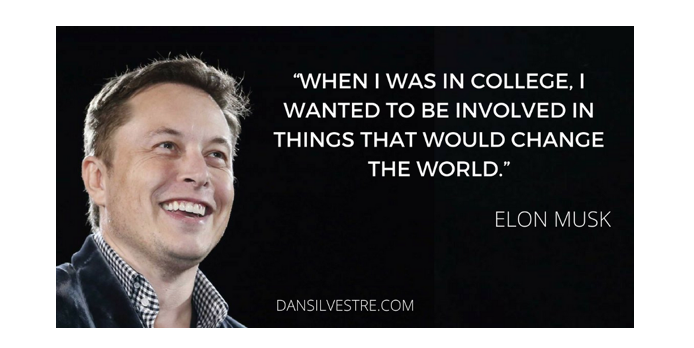
Musk is strategically multitasking. Whenever possible, it combines several tasks - this life hack is called batching. For example, he answers letters while he eats or meets with someone at dinner.
“I found that I can communicate with children and continue to write letters. I can spend time with them and work at the same time ... If I didn’t know how, I couldn’t do my job. ”
Another example - he sends letters and bills, talking on the phone or giving interviews.
How to apply
Research says multitasking is usually less effective than multitasking. The brain needs time to rebuild to another task, this is called task switching. It’s not the tasks themselves, but just this switching that bores you and makes you unproductive.
But if you package similar tasks that require similar types of thinking, you can effectively work on several tasks without slowing down the workflow. In other words, the brain focuses on one type of task at a time.
A couple of examples:
• Sketch out all blog posts at a time for the coming week.
• Process all the letters, messages in the messenger, phone calls and other types of communications at a time.
• Refresh multiple related tables at a time.
To understand what other tasks can be combined, write down all your main activities during the day and week, and think about what you can combine. Change the composition of the "packages" if necessary.
To speed up packaging, you can use the tomato method .
7. Plan
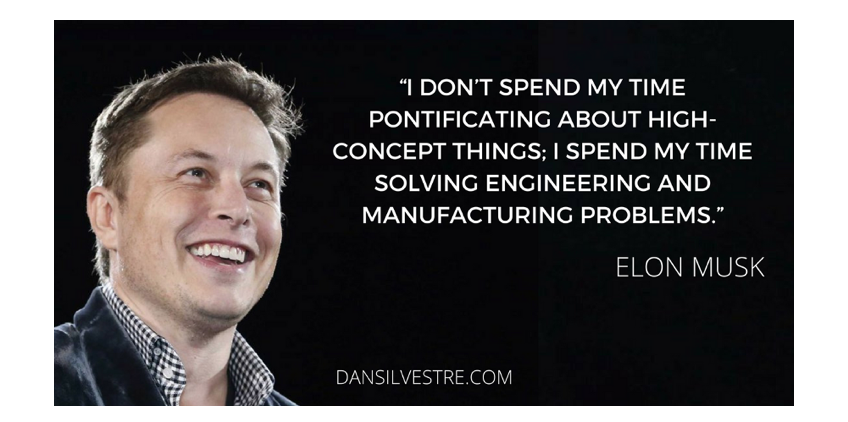
Managing three companies is a great feat, that is, time is an important factor for Mask. He constantly tries to optimize the use of time using feedback loops.
Like many other super-productive and successful people, Musk follows a very detailed and specific daily plan. He divides his calendar into five-minute segments, and it will not be easy for you to squeeze into one of them.
He gives priority to engineering, design and production, spending on them in the amount of 80% of his working time.
“I do not waste time ranting about something transcendental. I spend time solving engineering and production problems. ”
Dividing his day into five-minute segments, Musk plans more tasks for the day.
How to apply
The most productive people work with a calendar, not with a to-do list. Calendars are limited and allow you to better feel the time, so it’s easier for you to determine how much time you have to complete projects within a week.
Dividing the day into small segments and scheduling tasks on a calendar helps increase productivity. But you do not have to divide by five minutes. I believe that for my work it is more efficient to divide the day into 30-minute segments. Therefore, find the division that is best suited to you and your work.
And make sure you plan EVERYTHING: checking mail, calling customers, lunch and meetings. Everything should be on the calendar. Tear up the to-do list and work on the calendar.
8. Set ambitious goals
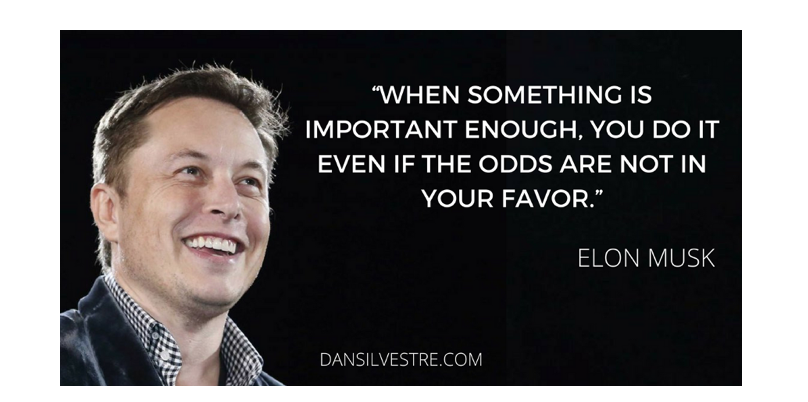
Perhaps one of the most famous features of the Mask is its tendency to set incredibly ambitious deadlines for the projects of its companies. He uses ambitious goals as a way to change perceptions:
“The first step is to demand the impossible. Then the probability will work. ”
Here is a story from the former SpaceX CEO: “It's as if he made everyone work on this machine, which is supposed to travel from Los Angeles to New York in one tank. They will work on the machine for a year and test all its components. When the car leaves for New York a year later, all the vice presidents secretly believe that it will get to Las Vegas at best. As a result, she reaches New Mexico - twice as far as they expected - and Ilon is still angry. He receives twice as much from people as anyone else. ”
The last phrase illustrates the power of ambitious goals. Even in the face of failure, your goal was so bold, so unattainable that you celebrate a small achievement because you thought that nothing would come of it.
Initially, Tesla planned to start deliveries of the Roadster in 2006. The company postponed the date several times until the machine became available in 2008. And although she left the assembly line almost two years late, Tesla became the first supplier of full-fledged electric vehicles.
“I say something, and then it usually comes true. Perhaps not on a schedule, but usually comes true. ”
Mask’s ambitious goals gave us a world in which electric cars are some of the best cars on the market, and finally reusable rockets appeared: “When Henry Ford made cheap, reliable cars, people said“ Ha, why do we need horses? ”He made a huge bet, and won. " Assigning targets that support the status quo will not give you reusable missiles.
How to apply
The essence of the purpose of ambitious goals is to take oneself out of the comfort zone. You will not develop by doing the same as before. Growth depends on your failures when you try to achieve more. If you set yourself five great goals, but achieved two, then you have already surpassed everyone who has never tried.
Ambitious goals require better and more intensive work; they force you to come up with new things more often, unlike ordinary tasks. And trying to achieve goals, you improve your skills to the level necessary for this.
At first, you won’t know how ambitious your goals should be. By trial and error, realize how many previous boundaries you need to push. But the most important thing is to start trying, and then make adjustments.
Next time you plan your work, take a few extra minutes to make an ambitious goal. Try to force yourself to do 50% more than is required for a common task. Be successful and be amazed at your incredible performance. This strategy is the first step towards impressive goals that you could not even think of before!
9. Develop a growth attitude
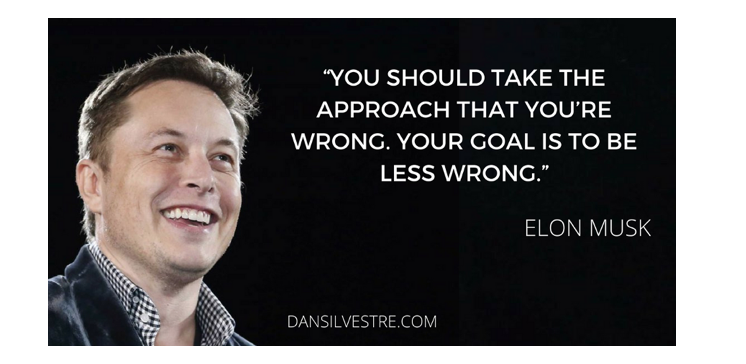
In 2004, Musk called the supplier to find out the price of an electromechanical actuator. The vendor requested $ 120,000. Based on the root cause, Musk figured out what components are needed and asked Steve Davis, who now works for SpaceX as the director of advanced projects, to make one actuator from scratch for less than $ 5,000. Davis spent nine months designing and building device, which cost $ 3,900 and flew into space in a Falcon 1 rocket.
Musk is never satisfied with the current situation. His companies have achieved tremendous success, but Musk knows that there is no limit to excellence - in all areas. You can always do better, faster or cheaper:
“Assume that you are mistaken. Your task is to make less mistakes. ”
This is called growth orientation, an important skill that distinguishes successful people from everyone else. Having developed such an attitude in yourself, you will know that you can learn anything if you make enough effort. And if you fail, then approach the task from the other side, until you find a working solution. You will try until it works out.
“Failure here is an option. If you do not fail, then you are creating little new. "
The opposite is the attitude toward constancy, when the current state of affairs is rarely reviewed. Everything will remain as it is, because "so accepted." Stereotypes are considered universal truths and are not in doubt. As a result, people are stagnating.
On the other hand, the development of a growth orientation in oneself allows one to grow both personally and professionally. And even if your daily achievements are small, they will accumulate over time. With a daily improvement of 1%, you will receive almost 38% improvement per year.
How to apply
Growth stems from solving complex problems, questions and problems. To succeed, you need to train your brain to perceive failures and difficulties as a form of progress, approaching a solution.
Here's how you can begin to develop a growth orientation in yourself:
Continuing study : expand your knowledge through books, learn from your personal difficulties and others. Loading your brain with fresh knowledge allows it to find new ideas and solutions that add value to your work and life.
Be persistent : change your perception and consider failure to be small delays and rewarding experiences. Adapt and re-implement your ideas, so that next time you can succeed.
Choose difficult : if you have a choice, then choose what is more difficult. Take challenges as opportunities to expand your skills and grow above yourself.
Accept failures: they happen in the life of each of us. All fail. Learn from them, analyzing what went wrong and how to fix it, use the new experience in your next attempt.
Be open to feedback : a critical success factor is effective and timely feedback on what needs to be improved. Be more open to feedback, even unconstructive.
Honor others : one is not a warrior in the field, so start supporting the successes of other people, and then they will not interfere with your successes. When your moment of glory comes, they will celebrate with you.
10. Expand your knowledge base
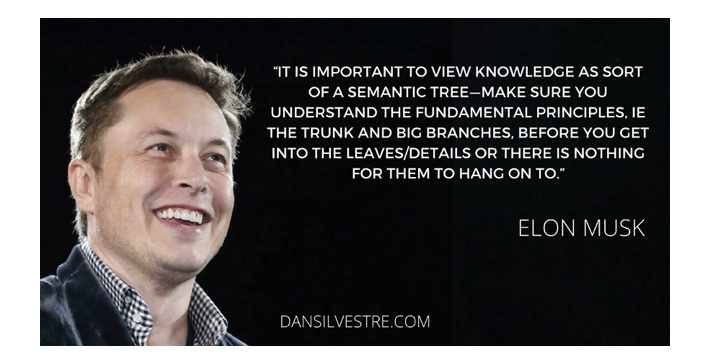
According to his brother, Musk at an early age read two books a day. He devoured knowledge. As a result, he began to be well versed in many sciences, such as physics, mathematics, engineering, and computer science.
One of my favorite quotes:
“It is important to consider knowledge as a semantic tree: understand the fundamental principles, which are the trunk and the main branches, before moving on to the leaves / details, otherwise they will have nothing to hang on”.
Even managing several companies, Musk constantly tries to learn from people around him who are better versed in specific topics. Quote from the book: “He can trap an engineer at the SpaceX factory and bombard him with questions about the type of valve or some material.
“At first I thought he was testing my knowledge,” said Kevin Brogan, one of the first engineers at the company. “And then I realized that he was just studying. He will question until he finds out 90% of what you know yourself. "
Over time, Musk developed “T-shaped” skills: great knowledge in one particular area and a solid amount of knowledge in many other disciplines and topics. This allows him to be a business shark, but at the same time, Mask uses his vast knowledge to create innovations and search for other solutions, he is more inventive and effectively collaborates with experts in other areas.
How to apply
Let's start with a practical example: you want to be healthy. To do this, it’s not enough to engage in some kind of sport. You need to learn a lot: learn the basics of a good diet, how to develop muscle, flexibility, how not to “plant” your heart with inept workouts, and so on. Deepening your knowledge in one area - sports - you also expand your knowledge in many other areas necessary for maintaining health. This is called T-shaped skills.
Let’s now look at someone working in the marketing or development department: in-depth knowledge about production planning and management, SEO and viral loops, as well as broad knowledge on many other topics, such as statistics, programming fundamentals, design principles and copywriting.
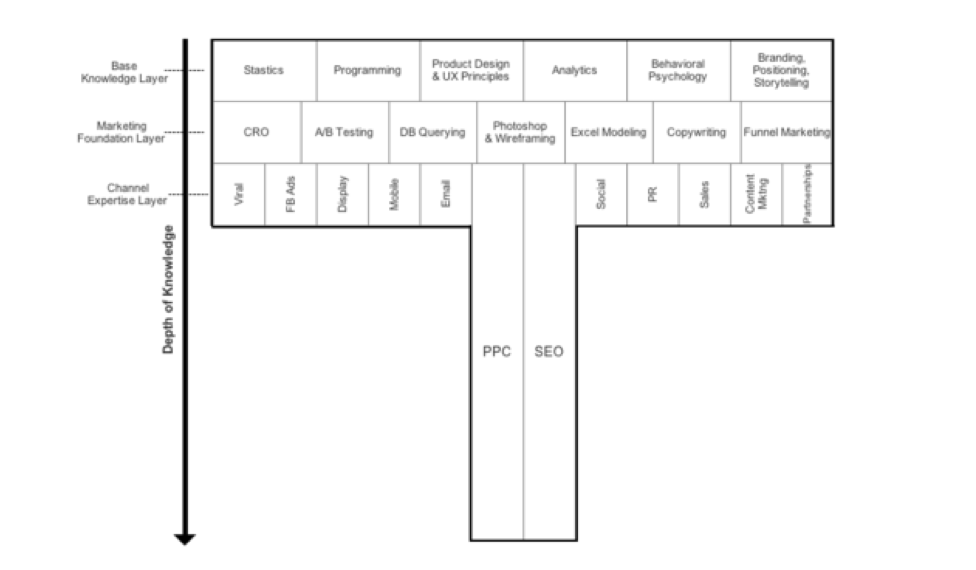
Here's how you can develop “T-shaped” skills in your field:
1. Draw a capital letter T and write a list of basic skills, secondary skills and basic knowledge. If this helps, model a successful person in your field of activity and his range of expertise.
2. See where you are now in each of these areas.
3. Improve your in-depth expertise with the help of books, courses, articles and other specialized specialists
4. Constantly re-evaluate yourself and improve your knowledge to become a “T-shaped” specialist
11. Bonus: shower
One of the most popular answers in the 2015 Reddit AMA thread was Mask's answer to the question: “What daily habit has had the greatest positive impact on your life?”. Musk answered simply: "Take a shower."

In another interview, Musk admitted that during a shower, the best ideas come to him: “It sounds like a real cliche, but the shower is probably the most ... you wake up, go to the shower, and, it seems to me, ideas have leaked into the subconscious, and although it didn’t happen in the shower, but it’s as if you are getting the result of night calculations.
I think this is also a useful productivity lesson: your brain worked all night, trying to find a solution in the background. A few minutes after waking up, it turns on - and this can happen in the soul - helping you to more clearly see the difficulties that are facing you.
Also, a shower is an opportunity to calmly think right after a night's rest. For example, you can plan a day or think about solutions to problems you face.
“I think an ordinary person can choose to become extraordinary.”
